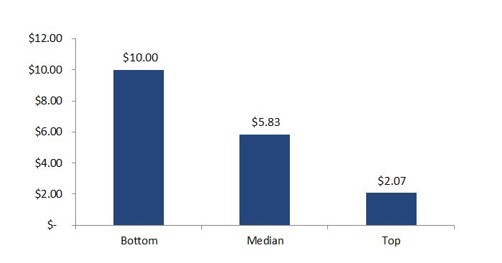Small- to medium-size businesses (SMBs) prioritize differently than large corporations. One size fits all does not apply when it comes to identifying the issues that are most related to keeping the company solvent and successful. Top 10 Challenges Small Businesses Are Facing Today, a recent article in the magazine Small Business Trends notes that SMBs’ most pressing concerns include better cash flow management, managing increasing employee healthcare costs, and dealing with anti-business government regulations and skyrocketing federal income taxes.
Automating invoice processing is the quickest way to address cash flow management, a top concern for SMBs. In the article, Metric of the Month, Accounts Payable Cost, data from the American Productivity and & Quality Center (APQC), a nonprofit benchmarking and best practices research organization, shows that calculated across industries, the median cost of processing an invoice can vary from about $10 per invoice to $2.07 in the top-performing organizations.
Median cost of invoice processing for companies surveyed by APQC
 Perry D. Wiggins, the CFO, secretary and treasurer for APQC says that top performing organizations invest in technology that automates accounts payable to reduce costs and improve cash flow. He notes that, “Regardless of industry, the lesser the human touch, the faster the process moves, and the fewer errors are likely to work their way in and require fixes later. Our research supports the logical assumption that manually entering invoices into the general ledger has a direct negative influence on the total cost of processing accounts payable per invoice.”
Perry D. Wiggins, the CFO, secretary and treasurer for APQC says that top performing organizations invest in technology that automates accounts payable to reduce costs and improve cash flow. He notes that, “Regardless of industry, the lesser the human touch, the faster the process moves, and the fewer errors are likely to work their way in and require fixes later. Our research supports the logical assumption that manually entering invoices into the general ledger has a direct negative influence on the total cost of processing accounts payable per invoice.”
5 Steps that Fuel Efficient Invoice Processing
 Alternatives in Engineering (AIE), based in Defiance, Missouri, has been in the fire protection design, inspection, and repair business since 1983. They currently handle over 23,000 support calls annually from several major retail, wholesale, and industrial complexes. Their staff coordinates with local contractors from around the country to maintain their clients’ fire protection systems, for example, inspecting and fixing a retail store’s sprinkler system. AIE is a certified woman-owned business that has stood the test time with their experience and expertise.
Alternatives in Engineering (AIE), based in Defiance, Missouri, has been in the fire protection design, inspection, and repair business since 1983. They currently handle over 23,000 support calls annually from several major retail, wholesale, and industrial complexes. Their staff coordinates with local contractors from around the country to maintain their clients’ fire protection systems, for example, inspecting and fixing a retail store’s sprinkler system. AIE is a certified woman-owned business that has stood the test time with their experience and expertise.
| Alternatives in Engineering's Invoice Workflow |
| 1. The invoice is stamped that it needs to be reviewed and is routed to a reviewer |
|
2. The reviewer checks the invoice to make sure all the details are accurate and stamps it to be paid |
| 3. The invoice is paid |
| 4. After the contractor is paid, the client is invoiced |
| 5. Once paid, the client invoice is stamped completed and filed in DocuWare |
DocuWare allowed AIE to simplify their previously complex invoice processing and expand the scope of their business while maintaining a smaller staff of highly skilled employees. Contractors now email their invoices in and the AIE team can easily index and store them in DocuWare.
DocuWare has made us way more efficient than we were 15 years ago and has given us the ability to take on new clients,” AIE president, Kati Smith explains.
Content Management by the numbers
 In terms of cost-savings, facts and figures confirm that investing in document management and office automation is well worth it. According to Content Management Returns $8.55 Per Dollar Spend to SMB Customers, a recently published research note from Nucleus Research, SMBs have just as much to gain from digitization as their larger counterparts.
In terms of cost-savings, facts and figures confirm that investing in document management and office automation is well worth it. According to Content Management Returns $8.55 Per Dollar Spend to SMB Customers, a recently published research note from Nucleus Research, SMBs have just as much to gain from digitization as their larger counterparts.
Nucleus defines an SMB as an organization with less than 500 employees. The analyst firm examined eight ROI case studies of SMBs that benefited from deploying content management systems. All the case studies were published within the past four years to take the wide adoption of cloud services into account.
Nucleus found that the three main benefits of investing in a document management system are increased productivity, cost savings from redeployed staff and/or reduced need for new hires, and reduced risk due to better records management.
Increased productivity: The average productivity increase was 36 percent with one customer achieved a 70 percent increase. The most modest increase was 20 percent.
Cost savings: Every Content Management implementation studied for the Nucleus report resulted in staff redeployment from manual tasks to high-value work or enabled the companies to expand their businesses without hiring new employees. An increase in the speed and ease of locating content and the ability to automate document capture and provide task lists and email reminders was a driving force behind these savings.
Reducing risk: SMBs can’t afford the risk of mismanaging customer or company information. Digitization enables companies to better meet the requirements of HIPAA, Sarbanes-Oxley, GDPR and other mandates by implementing workflow automation that ensures standards of control, security and privacy.
Automating invoice processing is the quickest way to start achieving these benefits with increased speed and accuracy in every process step. Time and effort spent are reduced by eliminating manual data entry, automating accounts payable workflow and exception handling, reclaiming early payment discounts, improving security and cutting audit prep time. Implementing a preconfigured, cloud-based solution provides additional advantages including faster deployment, and a more direct route to value while ensuring future-readiness and scalability as your business grows.


